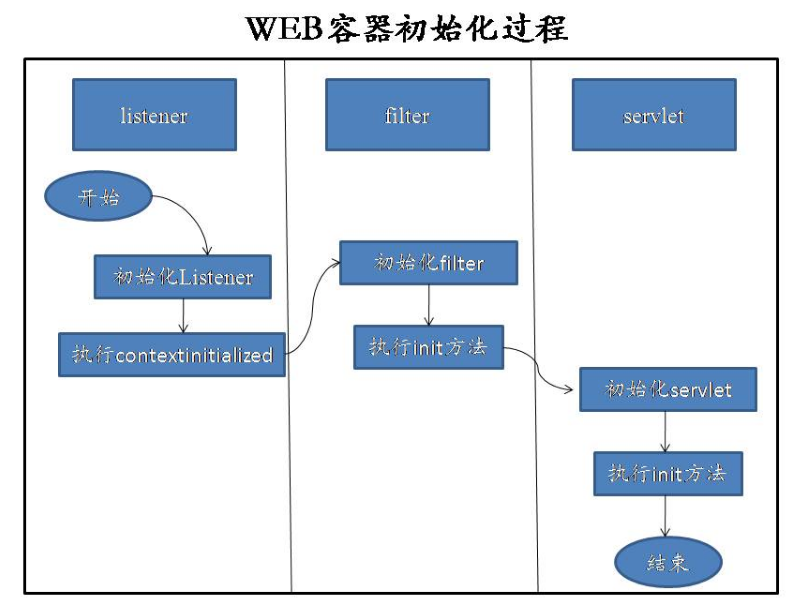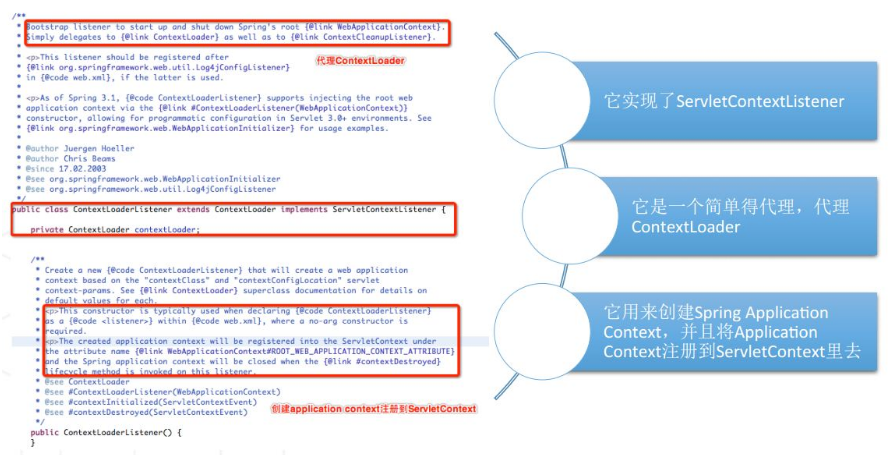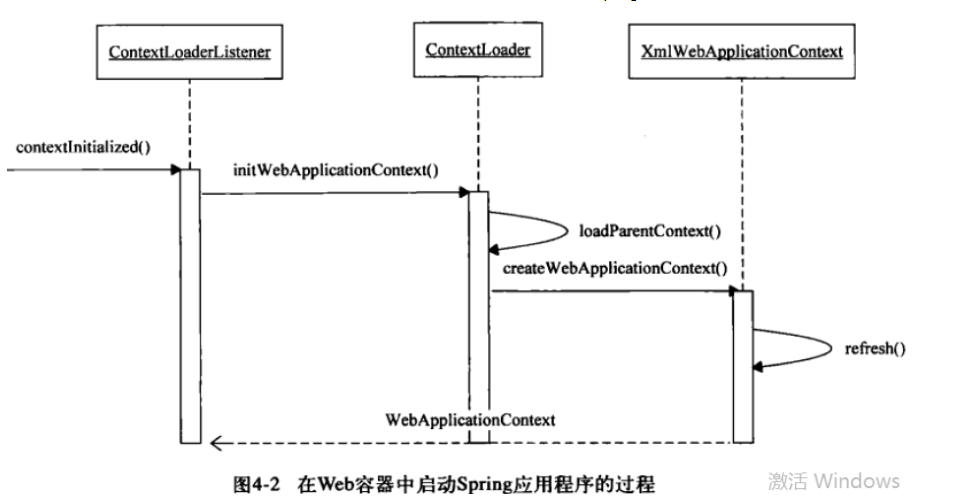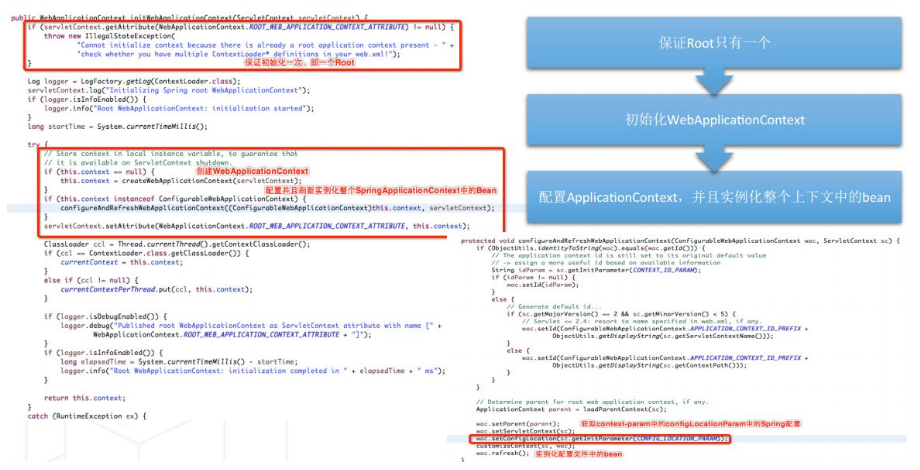前言
我们一般都知道怎样使用spring来开发web应用后,但对spring的内部实现机制通常不是很明白。这里从源码角度分析下Spring是怎样启动的。在讲spring启动之前,我们先来看看一个web容器是怎样的启动过程、也认识下ServletContextListener和ContextLoaderListener
阅读目录
- 一、java web容器的启动
- 二、认识ServletContextListener
- 三、认识ContextLoaderListener
- 四、Spring IOC容器的启动
一、java web容器的启动
我们先来看看java web容器是怎样的启动过程
1. 启动一个web项目的时候,web容器会去读取它的配置文件web.xml,读取<context-param>节点。
<context-param>包含了Web应用程序的servlet上下文初始化参数的声明
2.容器创建一个ServletContext(servlet上下文),这个web项目都将共享这个上下文。
3.容器将<context-param>转换为键值对,并交给servletContext。因为listener,filer等在初始化时会用到这些上下文信息,所以要先加载。
4.容器创建<listener>中的类实例,创建监听器。
5.加载filter和servlet。
load- on-startup 元素在web应用启动的时候指定了servlet被加载的顺序,它的值必须是一个整数。
如果它的值是一个负整数或是这个元素不存在,那么容器会在该servlet被调用的时候,加载这个servlet。如果值是正整数或零,容器在配置的时候就加载并初始化这个servlet,容器必须保证值小的先被加载。如果值相等,容器可以自动选择先加载谁。
web.xml 的加载顺序是:context-param -> listener -> filter -> servlet。

Spring工程中web.xml的配置
<context-param> <param-name>contextConfigLocation</param-name> <param-value>classpath:/applicationContext.xml</param-value> </context-param> <listener> <listener-class>org.springframework.web.context.ContextLoaderListener</listener-class> </listener>
其中<listener>标签中定义了spring容器加载器;
二、认识ServletContextListener

上图中是源码中接口ServletContextListener的定义,它定义了处理ServletContextEvent 事件的两个方法contextInitialized()和contextDestroyed()。理.
ServletContextListener能够监听ServletContext对象的生命周期,实际上就是监听Web应用的生命周期。当Servlet容器启动或终止Web应用时,会触发ServletContextEvent事件,该事件由ServletContextListener来处理。
三、认识ContextLoaderListener

上图中是类ContextLoaderListener的定义,它实现了上面的ServletContextListener。
ContextLoaderListener类用来创建Spring application context,并且将application context注册到servletContext里面去。
四、Spring IOC容器的启动
结合上面介绍的web容器的启动过程,以及接口ServletContextListener,ContextLoaderListener,我们来看看Spring IOC容器是怎样启动的。
我们知道在web.xml中都会有这个ContextLoaderListener监听器的配置,我们从上面的ContextLoaderListener接口的定义中可以看到,ContextLoaderListener它实现了ServletContextListener,这个接口里面的方法会结合web容器的生命周期被调用。因为ServletContextListener是ServletContext的监听者,如果ServletContext发生变化,会触发相应的事件,而监听者一直对这些事件进行监听,如果接受到了监听的事件,就会作于相应处理。例如在服务器启动,ServletContext被创建的时候,ContextLoaderListener的contextInitialized()方法被调用,这个方法就是spring容器启动的入口点。

我们从代码的角度,具体来看看:
/** * Initialize the root web application context. */ @Override public void contextInitialized(ServletContextEvent event) { initWebApplicationContext(event.getServletContext()); } /** * Close the root web application context. */ @Override public void contextDestroyed(ServletContextEvent event) { closeWebApplicationContext(event.getServletContext()); ContextCleanupListener.cleanupAttributes(event.getServletContext()); }
由于在ContextLoaderListener中关联了contextLoader对象,ContextLoader顾名思义就是context的加载器,由它来完成context的加载:

public WebApplicationContext initWebApplicationContext(ServletContext servletContext) { if (servletContext.getAttribute(WebApplicationContext.ROOT_WEB_APPLICATION_CONTEXT_ATTRIBUTE) != null) { throw new IllegalStateException( "Cannot initialize context because there is already a root application context present - " + "check whether you have multiple ContextLoader* definitions in your web.xml!"); } Log logger = LogFactory.getLog(ContextLoader.class); servletContext.log("Initializing Spring root WebApplicationContext"); if (logger.isInfoEnabled()) { logger.info("Root WebApplicationContext: initialization started"); } long startTime = System.currentTimeMillis(); try { // Store context in local instance variable, to guarantee that // it is available on ServletContext shutdown. if (this.context == null) { this.context = createWebApplicationContext(servletContext); } if (this.context instanceof ConfigurableWebApplicationContext) { ConfigurableWebApplicationContext cwac = (ConfigurableWebApplicationContext) this.context; if (!cwac.isActive()) { // The context has not yet been refreshed -> provide services such as // setting the parent context, setting the application context id, etc if (cwac.getParent() == null) { // The context instance was injected without an explicit parent -> // determine parent for root web application context, if any. ApplicationContext parent = loadParentContext(servletContext); cwac.setParent(parent); } configureAndRefreshWebApplicationContext(cwac, servletContext); } } servletContext.setAttribute(WebApplicationContext.ROOT_WEB_APPLICATION_CONTEXT_ATTRIBUTE, this.context); ClassLoader ccl = Thread.currentThread().getContextClassLoader(); if (ccl == ContextLoader.class.getClassLoader()) { currentContext = this.context; } else if (ccl != null) { currentContextPerThread.put(ccl, this.context); } if (logger.isDebugEnabled()) { logger.debug("Published root WebApplicationContext as ServletContext attribute with name [" + WebApplicationContext.ROOT_WEB_APPLICATION_CONTEXT_ATTRIBUTE + "]"); } if (logger.isInfoEnabled()) { long elapsedTime = System.currentTimeMillis() - startTime; logger.info("Root WebApplicationContext: initialization completed in " + elapsedTime + " ms"); } return this.context; } catch (RuntimeException ex) { logger.error("Context initialization failed", ex); servletContext.setAttribute(WebApplicationContext.ROOT_WEB_APPLICATION_CONTEXT_ATTRIBUTE, ex); throw ex; } catch (Error err) { logger.error("Context initialization failed", err); servletContext.setAttribute(WebApplicationContext.ROOT_WEB_APPLICATION_CONTEXT_ATTRIBUTE, err); throw err; } }
初始化web的context做了两件事情:
1.查看是否指定了父容器,如果存在父容器则获取父容器;
2.创建webApplicationContext,配置并且刷新实例化整个SpringApplicationContext中的Bean,并指定父容器。
因此,如果我们的Bean配置出错的话,在容器启动的时候,会抛异常出来的。
下面看看是怎样创建webApplicationContext的
protected WebApplicationContext createWebApplicationContext(ServletContext sc) {
//取得配置的Web应用程序上下文类,如果没有配置,则使用缺省的类XmlWebApplicationContext Class<?> contextClass = determineContextClass(sc);
//如果contextClass不是可配置的Web应用程序上下文的子类,则抛出异常,停止初始化 if (!ConfigurableWebApplicationContext.class.isAssignableFrom(contextClass)) { throw new ApplicationContextException("Custom context class [" + contextClass.getName() + "] is not of type [" + ConfigurableWebApplicationContext.class.getName() + "]"); }
//实例化需要产生的IOC容器 也就是实例化XmlWebApplicationContext return (ConfigurableWebApplicationContext) BeanUtils.instantiateClass(contextClass); }
实例化好XmlWebApplicationContext后,我们再来看看是如何配置ApplicationContext,并实例化bean的
protected void configureAndRefreshWebApplicationContext(ConfigurableWebApplicationContext wac, ServletContext sc) { if (ObjectUtils.identityToString(wac).equals(wac.getId())) { // The application context id is still set to its original default value // -> assign a more useful id based on available information String idParam = sc.getInitParameter(CONTEXT_ID_PARAM); if (idParam != null) { wac.setId(idParam); } else { // Generate default id... wac.setId(ConfigurableWebApplicationContext.APPLICATION_CONTEXT_ID_PREFIX + ObjectUtils.getDisplayString(sc.getContextPath())); } } wac.setServletContext(sc); String configLocationParam = sc.getInitParameter(CONFIG_LOCATION_PARAM); if (configLocationParam != null) { wac.setConfigLocation(configLocationParam); } // The wac environment's #initPropertySources will be called in any case when the context // is refreshed; do it eagerly here to ensure servlet property sources are in place for // use in any post-processing or initialization that occurs below prior to #refresh ConfigurableEnvironment env = wac.getEnvironment(); if (env instanceof ConfigurableWebEnvironment) { ((ConfigurableWebEnvironment) env).initPropertySources(sc, null); } customizeContext(sc, wac); wac.refresh(); }
这个refresh方法是我们后面讲IOC容器的重点,这里IOC容器启动也就到这里了。后面是真正的IOC怎么加载Resource、解析BeanDefinition、注册、依赖注入。





















 4038
4038











 被折叠的 条评论
为什么被折叠?
被折叠的 条评论
为什么被折叠?








